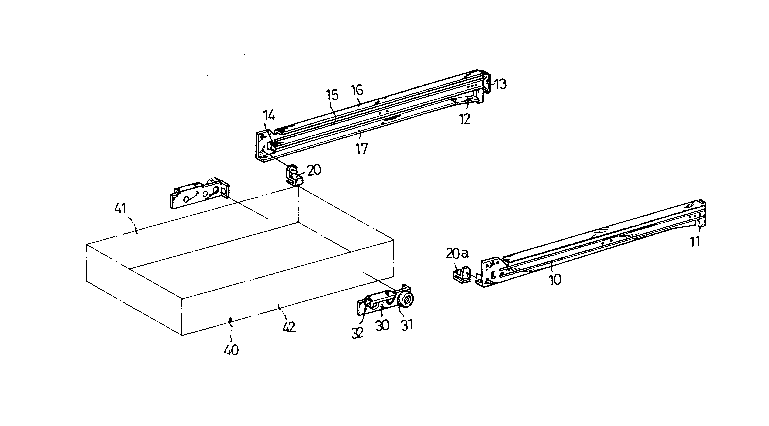Some of the information on this Web page has been provided by external sources. The Government of Canada is not responsible for the accuracy, reliability or currency of the information supplied by external sources. Users wishing to rely upon this information should consult directly with the source of the information. Content provided by external sources is not subject to official languages, privacy and accessibility requirements.
Any discrepancies in the text and image of the Claims and Abstract are due to differing posting times. Text of the Claims and Abstract are posted:
| (12) Patent Application: | (11) CA 2073365 |
|---|---|
| (54) English Title: | TRACK MEANS FOR DRAWERS |
| (54) French Title: | RAILS COULISSANTS POUR TIROIRS |
| Status: | Deemed Abandoned and Beyond the Period of Reinstatement - Pending Response to Notice of Disregarded Communication |
| (51) International Patent Classification (IPC): |
|
|---|---|
| (72) Inventors : |
|
| (73) Owners : |
|
| (71) Applicants : | |
| (74) Agent: | SMART & BIGGAR LP |
| (74) Associate agent: | |
| (45) Issued: | |
| (22) Filed Date: | 1992-07-10 |
| (41) Open to Public Inspection: | 1994-01-11 |
| Examination requested: | 1992-07-10 |
| Availability of licence: | N/A |
| Dedicated to the Public: | N/A |
| (25) Language of filing: | English |
| Patent Cooperation Treaty (PCT): | No |
|---|
| (30) Application Priority Data: | None |
|---|
IMPROVED TRACK MEANS FOR DRAWERS
ABSTRACT
A track assembly for drawers includes a pair of spaced
stationary tracks securely mounted to longitudinal walls of
a piece of furniture which define a space for accommodating
a drawer and a pair of sliding members securely mounted to
outer longitudinal surfaces of the drawer which face the
stationary tracks. Each stationary track includes a strip
having an upper flange and a lower flange respectively
protruding from an upper edge and a lower edge thereof and
extending along a length thereof, thereby defining a sliding
track for the sliding member. The sliding members are
mounted to both outer longitudinal surfaces of the drawer
adjacent to a rear end thereof. A roller rotatably mounted
on each of the sliding members is received and rotatable in
the track, providing a smooth operation of the drawer. A
block is mounted to a front end of the stationary track and
has a smooth upper surface to support an underside of the
drawer, thereby providing a smooth supporting point for the
drawer during operation. A rear stop and a front stop are
respectively mounted to a rear end and a front end of the
stationary tracks for preventing the drawer from moving out
of the stationary tracks.
Note: Claims are shown in the official language in which they were submitted.
Note: Descriptions are shown in the official language in which they were submitted.

2024-08-01:As part of the Next Generation Patents (NGP) transition, the Canadian Patents Database (CPD) now contains a more detailed Event History, which replicates the Event Log of our new back-office solution.
Please note that "Inactive:" events refers to events no longer in use in our new back-office solution.
For a clearer understanding of the status of the application/patent presented on this page, the site Disclaimer , as well as the definitions for Patent , Event History , Maintenance Fee and Payment History should be consulted.
| Description | Date |
|---|---|
| Inactive: IPC expired | 2017-01-01 |
| Inactive: IPC expired | 2017-01-01 |
| Inactive: IPC from MCD | 2006-03-11 |
| Time Limit for Reversal Expired | 1995-01-10 |
| Application Not Reinstated by Deadline | 1995-01-10 |
| Deemed Abandoned - Failure to Respond to Maintenance Fee Notice | 1994-07-11 |
| Inactive: Adhoc Request Documented | 1994-07-11 |
| Application Published (Open to Public Inspection) | 1994-01-11 |
| All Requirements for Examination Determined Compliant | 1992-07-10 |
| Request for Examination Requirements Determined Compliant | 1992-07-10 |
| Abandonment Date | Reason | Reinstatement Date |
|---|---|---|
| 1994-07-11 |
Note: Records showing the ownership history in alphabetical order.
| Current Owners on Record |
|---|
| CHING T. LEE |
| Past Owners on Record |
|---|
| None |